This evergreen climbing plant is sometimes also called the Flame Vine, but it's Botanical name is Pyrostegia venusta. A native to Brazil, it is frost-tender so it's suitable only for temperate to warm climates. Plant it in a sheltered sunny postion , and provide a sturdy trellis or pergola for it to climb over, because when it flowers in late winter/spring, the plant becomes very heavy. It is ideal to plant in positions where you need privacy as it quickly covers a large area of a fence if provided with adequate support. I took these photos in North Sydney.
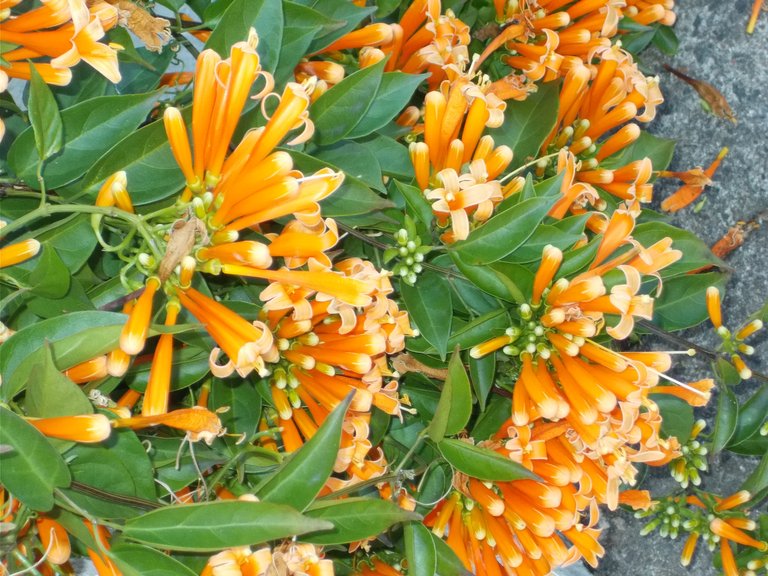
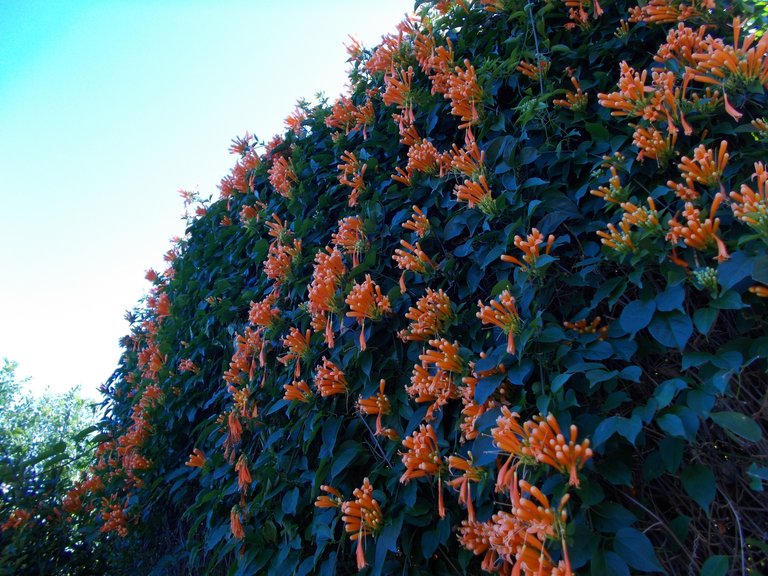
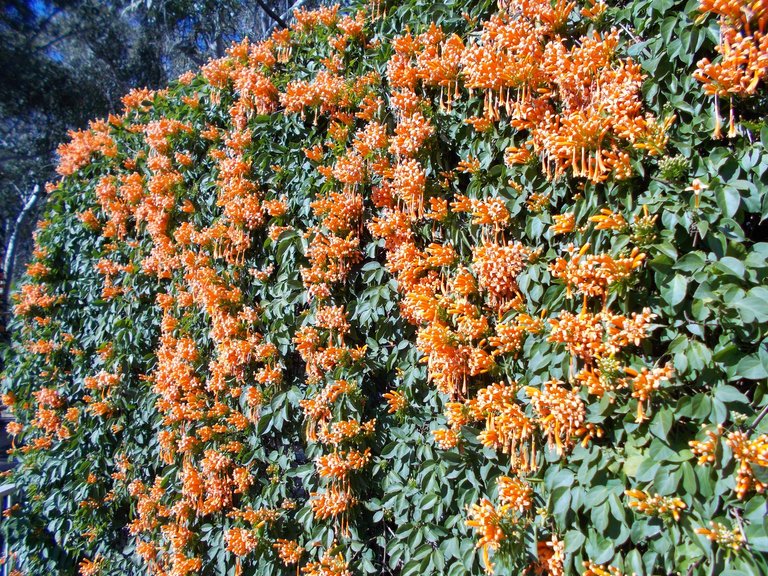
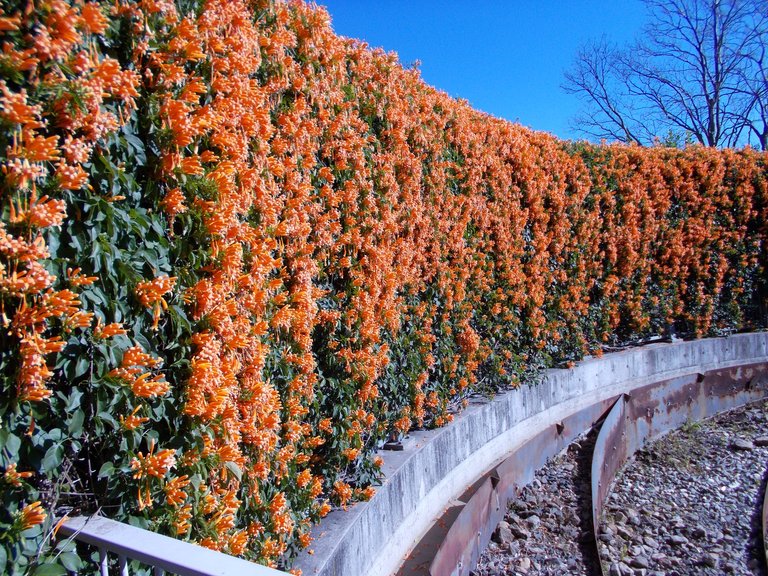
Shared on twitter promoting good quality content on #Steemit. Stephen
#PromoSteem #steemtalent #JoinSteemit #Steemit
Blaze into the Spring with the Orange Trumpet Vine. #steemtalent #JoinSteemit #Steemit @Steemit
#pyrostegia #plants #garden #gardenersworld #australia
Thanks for promoting the post !
You are very welcome. It's my pleasure. Stephen
Pyrostegia venusta is a liana (a vigorous, woody climber) that makes a beautiful ornamental plant with cascades of orange flowers. It is commonly grown in tropical and subtropical areas, as well as in mild Mediterranean climates. The plants form dense masses, growing up trees, on walls or over rocks, and are covered with flowers in the cool, dry season.
http://powo.science.kew.org/taxon/urn:lsid:ipni.org:names:110483-1
Fav. comment Award !! Very nice choice of Pics, thanks.
The fire liana has many names: Flame Vine, Flaming Trompete, Golden Shower, Orange Trumpet Vine, Hua Pala Vine ... But it is scientifically called Pyrostegia venusta: Pirostegia is charming.
Pyrostegy - evergreen with bright orange flowers. Pyrostegia is a real liana up to 25 m long, fixed on the support with the help of antennae. The main ornamentality of the plant is attached to large inflorescences with long non-expanding elongated flowering buds. The opened flowers quickly disappear from the sepals, continuing for some time to hang on long curved stamens. Pyrostegia is a charming pyrostegia venusta - the only one of the 4 species of the genus Pyrostegia, widespread in the tropical and subtropical climate of the New World as an ornamental garden and park plants.
http://www.sweet-live.ru/post283631192/
Fav. comment Award. Excellent choice of Pics.
Pyrostegia venusta (Flame Vine) - Flame vine is one of the most spectacular flowering vines in cultivation. It is a vigorous, evergreen liana (a name for large woody climbers) that can spread quickly by tendrils to the top of whatever supports it, including fences, other plants or even small buildings by branching profusely and climbing using its clinging tendrils. It produces clusters of spectacular orange flowers in the fall through winter; the tubular flowers with exerted style and stamens are about 3 inches long and occur in clusters of 15-20 at the tips of branches and they often hang downwards under their own weight so are well displayed from below. Fruit, when set, is a slender dry capsules about 1 foot long. Plant in full sun or part shade and water regularly.
It is cold hardy to short durations temperatures down to 25° F and resprouts from the ground if nipped back. Though we think of this vine more as a plant for coastal gardens, we have been told by a gardener that he has quite successfully grown this plant in the heat of the Arizona desert. It is a vigorous vine that left on its own will densely cover what is supporting but it can be easily pruned to maintain a more open look and is a useful vine to cover an arbor or trellis at the front gate, trained on a rock wall or to cover a long fence line. It is attractive to hummingbirds.
https://www.smgrowers.com/products/plants/plantdisplay.asp?plant_id=1332
This evergreen climber bears the most wonderful showers of orange, tubular flowers in winter/spring. It has attractive, lush green leaves which are paired along the sinewy, thin branches.
This vigorous plant has strong twiners which will cling to almost anything, including bare brick walls - though a strong trellis or fence is best as when it is full of bloom it will be quite heavy. It will flower at its best in a sheltered sunny position and be an absolute delight in winter when many other flowers are dormant.
This is a hardy plant it will tolerate coastal conditions and once established frost, drought and even neglect
https://www.gardensonline.com.au/GardenShed/PlantFinder/Show_1373.aspx
A vigorous evergreen climber which supports itself by means of coiled, thread-like tendrils growing from the apex of some of the bright green compound leaves. Abundant, bold orange flowers are produced from about mid July until October.
Pyrostegias are warm climate plants. They grow well in Sydney to Perth and areas north. They are also worth trying in coastal gardens further south and in Adelaide and inland areas in a warm position, with shelter from cold winds and frost
Striking when draped over a building or a structure such as a carport or over an old fence. A good choice in a country garden to conceal the tank stand.
The orange trumpet vine likes a sunny spot, excellent drainage and regular moisture particularly when it’s hot and dry. It also needs protection from frost and a support to climb over. Prune away spent flowers to encourage new growth in spring if desired.
Source
Beautiful ! Silly sausage Award !! Great Pics and info.
Thanks alot sir.
This plant is very common on Magnetic Island, and is generally referred to as ‘Japanese Honeysuckle’. It is, however, neither Japanese, nor a honeysuckle!
This is a vigorous, fast-growing, evergreen woody vine that blooms in winter and spring with spectacular reddish orange flowers. The compound leaves have two or three 5–7.5 cm oval leaflets, and are arranged in pairs opposite each other on the stem. Often the centre leaflet is modified into a coiled, 3-part tendril. It branches profusely, and climbs by clinging with its tendrils. A single plant can reach to about 30 m long. The tubular flowers are about 7.5 cm long, and are borne in clusters at the tips of branches. The corolla has 5 lobes that are bent backwards, and the long orange stamens and style extend beyond the tube. The flower clusters may hang down under their own weight. The fruits are slender dry capsules about 30 cm long. The vine is native to southern Brazil, northern Argentina, Bolivia and Paraguay.
Source: https://www.somemagneticislandplants.com.au/index.php/plants/299-pyrostegia-venusta
A beautiful plant, my friend and Pyrostegia venusta is a low-maintenance vine, but like all vining plants, pruning is something it cannot do without!
Light: Prefers full sun to light shade. Tolerates partial shade but grows and blooms best with good sunlight.
Moisture: Medium water needs. Though highly drought tolerant when established, good to water regularly especially during hot and dry seasons.
Soil: Moderately fertile, light and moist, but well-drained soil. It tolerates many kind of soils: acidic, alkaline, clayey, sandy or loamy.
Others: Hard prune after flowering to encourage branching and promote more flowers, as well as to restrain huge and unruly size. It’s hardy and can tolerate severe prune if needed. Benefits from fortnightly or monthly feed with a flowering fertilizer though it require minimal feeding. Generally, pest and disease free but do watch out occasionally for scales, caterpillars and mites.
For subtropical regions: Hardiness: USDA Zone 9-11. Blooms sporadically all year long but perform best from late fall through winter but not in freezing regions. Shelter from cold winds and frost that may ruin young flowers and plant.
Propagation: Easily propagated vegetatively from semi-hard cuttings, suckers or layering. Also, by seed germination.
Usage: As a spectacular ornamental vine, Flame Vine is excellent for landscaping and to cover and decorate garden fences, trellises, arbors and arches and walls. Train them high if possible for the dramatic and spectacular floral display. For subtropical and frost-free regions, grow it to bring sunshine to your winter garden as it blooms best in winter when most others are sleeping.
Grow it as an attractant for hummingbirds and other pollinators if you’re a nature lover.
Pyrostegia venusta is used in traditional Brazilian medicine as a general tonic for treating diarrhea, vitiligo, cough, and common diseases of the respiratory system related to infections, such as bronchitis, flu and cold (ref.: NCBI, US PubMed). Thank you @ctrl-alt-nwo
http://www.jaycjayc.com/pyrostegia-venusta-flamevine/#.W4lqEM4zbDc
This evergreen climber bears the most wonderful showers of orange, tubular flowers in winter/spring. It has attractive, lush green leaves which are paired along the sinewy, thin branches.
This vigorous plant has strong twiners which will cling to almost anything, including bare brick walls - though a strong trellis or fence is best as when it is full of bloom it will be quite heavy. It will flower at its best in a sheltered sunny position and be an absolute delight in winter when many other flowers are dormant.
This is a hardy plant it will tolerate coastal conditions and once established frost, drought and even neglect
https://www.gardensonline.com.au/GardenShed/PlantFinder/Show_1373.aspx
This interesting plant reminds me of candles for Christmas :)
This evergreen climber bears the most wonderful showers of orange, tubular flowers in winter/spring. It has attractive, lush green leaves which are paired along the sinewy, thin branches.
Source
This vigorous plant has strong twiners which will cling to almost anything, including bare brick walls - though a strong trellis or fence is best as when it is full of bloom it will be quite heavy. It will flower at its best in a sheltered sunny position and be an absolute delight in winter when many other flowers are dormant.
Source
This is a hardy plant it will tolerate coastal conditions and once established frost, drought and even neglect.
Source
Flowers with warm tones of pink or red contrast with green foliage for eye-catching color. Two such plants are pink trumpet vine (Podranea ricasoliana) and the cross vine cultivar "Atrosanguinea" (Bignonia capreolata "Atrosanguinea,")
Pink Trumpet Vine
Source
Cross Vine Cultivar
Source
Text from multiple Google souces
I have seen this plant and they are indeed very beautiful and their colors are indeed beautiful as well :)
My images of them :)
Are they your own photos ?
Yes they are
The images that I do post in my Blog they all belong to me
Only few numbers that does not belong to me I add the source.
While the flower images are captured by me
I thought they might be. It's good that you had a plant that around your local area.
Yeah that sure is. While you sure have some great collection as well :)
Flame Vine plants are also known as 'Orange Trumpets'. This plant is suitable for ornamental plants because flowers that resemble fire (fire) are called fire vines.
As for the specifications of this flower, as follows:
Following are some collections:
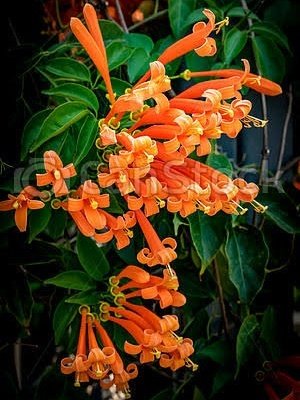
Source:
http://bibitbunga.com/flame-vine/
@ctrl-alt-nwo,
Wow it's well suited to the fences! Look the native plant of Brazil well grown here in Sydney! Wonderful collection of photography and great information about the "Orange Trumpet Vine"! Really appreciate your effort!
Cheers~
Beautiful views, @ctrl-alt-nwo
I've never heard of this plant before.
Thank you for showing such bright photos )
source
Wow! These are wonderful orange waterfall of flowers! Lovely colours and very dense shrub to give privacy!
I will have a look around if I could find it here.
Cheers.
Oh yeah, great plant @ctrl-alt-nwo and Pyrostegia venusta is a perennial, evergreen vine that comes from tropical and subtropical regions of South and Central America. It is widely spread in open fields, shrublands, edges of forests and coastal areas, and is often planted in gardens. It climbs or creeps at fast rate, with length range of around 12m.
It likes slightly acidic soil but tolerate neutral, slightly alkaline or saline conditions. It grows and flowers best in full sunlight. It doesn't flower well in hot and humid conditions, but it is all covered in bloom for long time when season is dry and temperatures are cooler. If your plants don't produce many flowers, pruning might help. It is also important not to overfeed Pyrostegia. In very fertile and moist soil it will grow rapidly, but you won't see many flowers on it, if any, even during the peak of it's flowering season. It copes well with extreme heat and can survive slight frost. In regions with cold winters it can be grown as a pot plant.
Pyrostegia can be propagated from seeds (flowers are only polinated by coliber birds), by cuttings or layering. In some places it is considered as an invasive plant.
If you have access to the plant at all time, I dont see any reason why you should dry and storage it. I don't have informations that would confirm this, but i think that just like most of herbs Pyrostegia is best to be used fresh whenever possible. Plus, why to make a fuss with drying it, if the teas from it's fresh or dried leaves and flowers taste nearly the same. Of course you might want to gather and dry some flowers to storage for later, as it might not appear for long in your region (in some places it is in bloom for half a year or nearly whole year round). Chinese says that leaves and flowers of Pyrostegia can be sun dried, but I always prefer to dry those parts of herbs in shade, as some bioactive substances are getting damaged by strong sun rays exposure.
http://herbsfromdistantlands.blogspot.com/2017/04/pyrostegia-venusta-flame-flower-golden.html
Very beautiful plant indeed and useful too for making a fence covering for the purpose of privacy or maybe on a trellis to make a shade out of it @ctrl-alt-nwo and it is better than some vines because of its sunny beautiful flowers with nectar.
Native to the Southeast, trumpet vine (Campis radicans) is a large, vigorous deciduous vine prized for its showy trumpet-shaped flowers that bloom in varying shades of red, orange or yellow. This woody plant is so aggressive it’s considered invasive in some regions. As its beautiful flowers fade, they produce large seed pods which, as they dry and split, drop hundreds of seeds, sending up suckers. As summer days heat up, the vine puts out large numbers of tendrils that reach for anything in sight and will grow into thick woody vines within no time.
Trumpet vine adapts to almost any soil, except heavy and wet ones, and is drought-tolerant. Because it blooms on new wood, prune it in the spring after flowering, and it may require a heavy (as in brutal) pruning every couple of years. If you’re really concerned about its invasiveness, consider the variety ‘Madame Galen’ which is a little less hardy and grows slower than most others.
Source
It's Pyrostegia, not Campsis, but your pics are the right plant , very nice !
Orange trumpet vine (Pyrostegia venusta) is one of the most spectacular winter flowering climbers you can find and is sometimes called the flame vine. If you want to make a statement in your winter garden then this is the plant for you!
The orange trumpet vine is usually trouble free but occasionally mites can appear. Spray with eco-oil when you first see them and repeat the spray if needed.
This vigorous, twining climber comes from South America and is well suited to Australian soils and climate. It’s magnificent orange flowers appear in winter and last right through to spring. It will easily cover a boring fence or garden shed but why not grow it on a pergola or arch for where the flowers can hang down on display. Suits many garden styles including cottage, tropical, coastal or modern.
https://ecoorganicgarden.com.au/gardening-tips/how-to-grow-the-orange-trumpet-vine/
Wow! Trumpet Vine is an amazing flowers. It looks gorgeous. I also appreciate your perfect photography of Trumpet Vine.
image source
image source
image source
Thank you sir @ctrl-alt-nwo for always sharing new beautiful flowers and plants.
Pyrostegia VenustaFlame Vine (Pyrostegia Venusta) is a flower plant that grows very fast by propagating and twisting which can produce thousands of orange-colored flowers blazing brightly.
Scientific Classification:
Planting place:
Pot diameter> 40cm or directly planted on the ground.
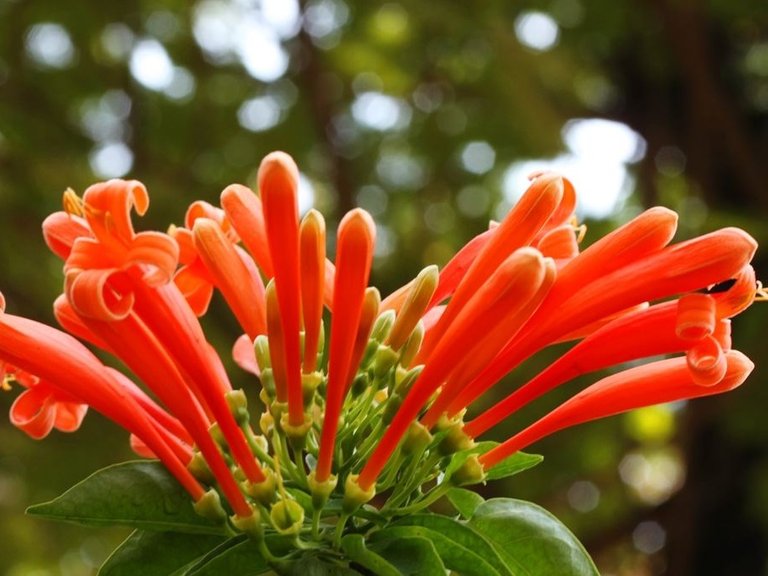
Care Tips:
Sources :
Image from Pinterest!
https://www.google.co.id/url?sa=t&source=web&rct=j&url=http://bibitbunga.com/flame-vine/&ved=2ahUKEwiQy6Pa7ZfdAhXGfSsKHaZYCHEQFjAKegQIARAB&usg=AOvVaw0s1Hjga47cbuz0mw63KKKd
Orange Trumpet Vine blazing all the way with that looks beautiful :D
beautiful color!! I saw a lot of them in "better" suburbs. probably because of the reason you said, to keep privacy.
Amazing photos. I'm very interested in learning about new, impressive plants that grow in your area. P.S. the last photo - the most beautiful.
Gorgeous, makes an attractive screen. :-)
It is a pity that this beauty does not tolerate frosts. Interestingly, they say that this honey plant, but it does not attract a lot of insects, it's a paradox. This plant is poisonous, it is interesting how in medicine this poison is used. I have not found other uses other than treating diarrhea. There are many poisonous plants in our region. But, they are considered medicinal plants and have a wide range of applications.
you are really very talented person.because its expressed to doing your writing perfect skills and everyday showing new plant post in your blog.i think that,we can knowing to read your daily post alots of nature beauty main part of flower matter. i am first time heard this amazing pyrostegia venusta plant matter.this pyrostegia venusta flower looks very impressible. its my new experience to see your flower. your describing style really very impressible.i like your every work.because your work anytime perfect and real.everyday i am got alots of new idea of various kinds of flower.flower always main symbol of nature beauty. this pyrostegia venusta flower very attractive flower and its suitable only for temperate to warm climates. you really capture very fantastic flower plant of north sydney.but my country not available this plant.you pic up this flower just marvelous.you capturing this photo proper style.its very big quality one of them you.if when my country i see this fantastic plant obviously i am doing growing my house garden this amazing flower plant any house roof. your showing flame benus flower just beautifull.thanks to sharing for your awesome creativity.i am always attracted them.i want you stayed anytime live long happily in your whole life.i wish that you success being your future and your all dreams comes true.may god bless you.my best wishes anytime with you.all the best.keep it up..take care yourself and best of luck of your great work.. my good friend.. @ctrl-alt-nwo
Nice to know about this beautiful native Brazilian flower. Trumpet Vine is really a very beautiful flower. I also appreciate your captured photography from Sydney.
photo source
photo source
Always appreciate your flowers article. Keep it up sir.
The star players are Flame Vines (Pyrostegia venusta), engulfing entire buildings, compounds and pergolas in masses of glorious orange blooms. No prizes for guessing why they’re called so, but if here’s a plant that can make the humblest dwelling look like a piece of paradise, in the fleeting few months that it is in bloom.

Source
Flame vines are natives of South America, found in the wild in Brazil and Paraguay. They’ve been domesticated for a couple of centuries now, growing best in tropical zones with relatively cooler winters. In India, they bloom around Sankranti, which gives them their name Sankrant-Vel in Marathi. The brilliant orange hue of the flowers gives them their name Thangappu (goldflower) in Tamil, and rather amusingly, Golden Showers in Bengaluruspeak. They are important Feng-Shui plants too, said to bring luck and prosperity to homes. Flame vines are from the Bignoniaceae family, home to a host of beautiful flowering shrubs and vines. They have exactly one glorious blooming period every year, producing thousands of inflorescences of tube-like flowers, favourites with nectar seeking insects and birds. Pollinated flowers drop off a couple of days after blooming and form slender seed pods, bearing dozens of viable seeds, ready for the next generation.
Congratulations @ctrl-alt-nwo!
Your post was mentioned in the Steemit Hit Parade in the following category:
Thanks !!
It looks like a wonderful garden fence.
The beauty of Brazil is decorated with northern Sydney.
An interesting plant, thank you for sharing.
Greetings :)
Trumpet vine (Campsis radicans), also known as trumpet creeper, is a fast-growing perennial vine. Growing trumpet vine creepers is really easy and although some gardeners consider the plant invasive, with adequate care and pruning, trumpet vines can be kept under control. Keep reading to learn more about how to grow trumpet vine.

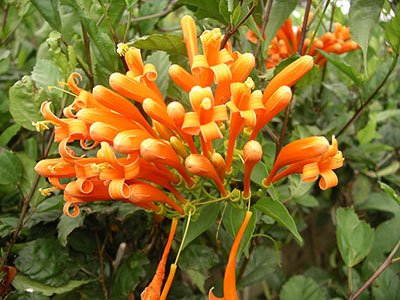
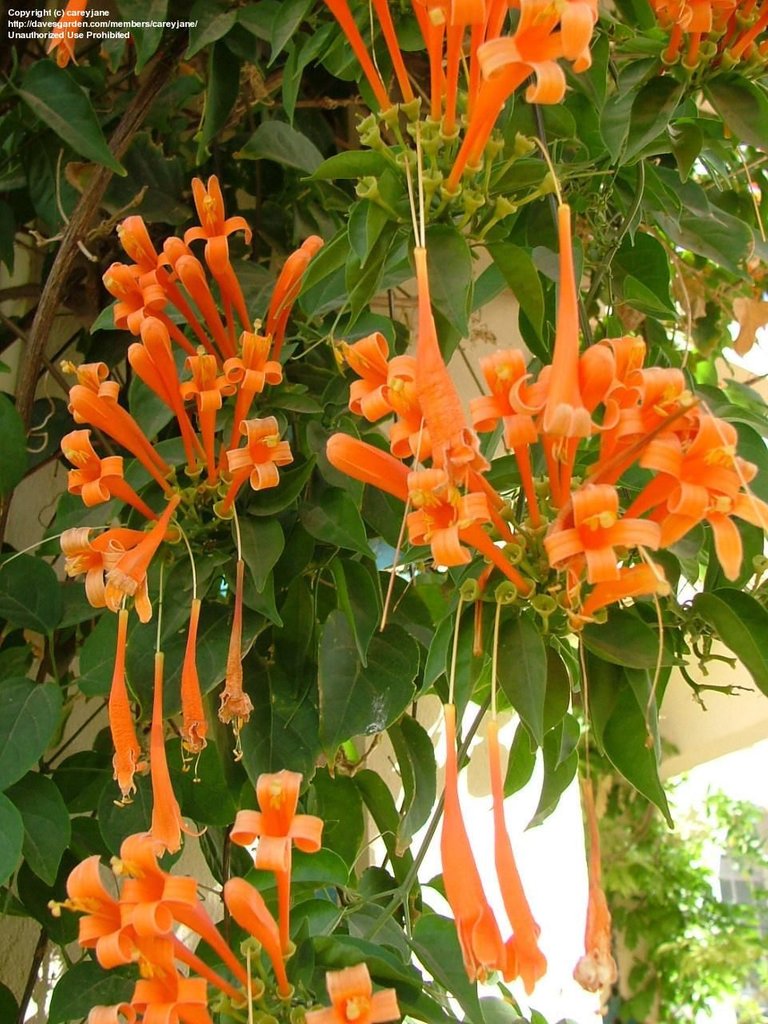
Trumpet Vine Plant The trumpet vine flower is great for attracting hummingbirds to the landscape. The beautiful tubular flowers range in color from yellow to orange or red. Blooming on the trumpet vine plant takes place throughout summer and into fall, though blooming may be limited for those planted in shady locations. Following its flowering, trumpet vines produce attractive bean-like seedpods. Trumpet vine plant is hardy in USDA plant hardiness zones 4-9. The woody vines are usually strong enough to endure winter while other growth will generally die back, returning again in spring. Since these vines can reach 30 to 40 feet in just one season, keeping their size under control with pruning is often necessary. If allowed to grow, trumpet creeper can easily take over and is extremely difficult to get rid of.
Home › Ornamental Gardens › Vines › Trumpet Vine Trumpet Vine Plant: How To Grow Trumpet Vine Trumpet Vine By: Nikki Tilley, Author of The Bulb-o-licious Garden Printer Friendly Version Image by sorsillo By Nikki Tilley (Author of The Bulb-o-licious Garden) Trumpet vine (Campsis radicans), also known as trumpet creeper, is a fast-growing perennial vine. Growing trumpet vine creepers is really easy and although some gardeners consider the plant invasive, with adequate care and pruning, trumpet vines can be kept under control. Keep reading to learn more about how to grow trumpet vine. Trumpet Vine Plant The trumpet vine flower is great for attracting hummingbirds to the landscape. The beautiful tubular flowers range in color from yellow to orange or red. Blooming on the trumpet vine plant takes place throughout summer and into fall, though blooming may be limited for those planted in shady locations. Following its flowering, trumpet vines produce attractive bean-like seedpods. Trumpet vine plant is hardy in USDA plant hardiness zones 4-9. The woody vines are usually strong enough to endure winter while other growth will generally die back, returning again in spring. Since these vines can reach 30 to 40 feet in just one season, keeping their size under control with pruning is often necessary. If allowed to grow, trumpet creeper can easily take over and is extremely difficult to get rid of. How to Grow Trumpet Vine This easily grown vine thrives in both sun and partial shade. While it prefers a nice well-draining soil, trumpet vine flower is resilient enough to adapt to nearly any soil and will grow readily. Be sure to choose a suitable location prior to planting as well as a sturdy support structure. Planting too close to the home or outbuilding could result in damage from the vine’s creeping roots so it’s important that you plant the vine some distance from the home. They can work their way under shingles and even cause damage to foundations. A trellis, fence, or large pole works well as a support structure when growing trumpet vines. However, do not allow the vine to climb trees as this can lead to strangulation. When growing trumpet vines, containment is another consideration. Some people find it useful to plant trumpet creeper in large bottomless containers, such as 5-gallon buckets, which can be sunk into the ground. This helps keep the vine’s spreading habit under control. If the vine is located in a large enough area where its suckers can be routinely mown and pruned, it can be grown without support and treat more like a shrub.
https://www.gardeningknowhow.com/ornamental/vines/trumpet-vine/growing-trumpet-vines.htm
Thie first Pic is not the same plant as Pyrostegia venusta. Be careful with common names, always search the Botanical name i provide, then you get the right plant . Thanks for the nice pics though !
Trumpet Creeper, Trumpet Vine


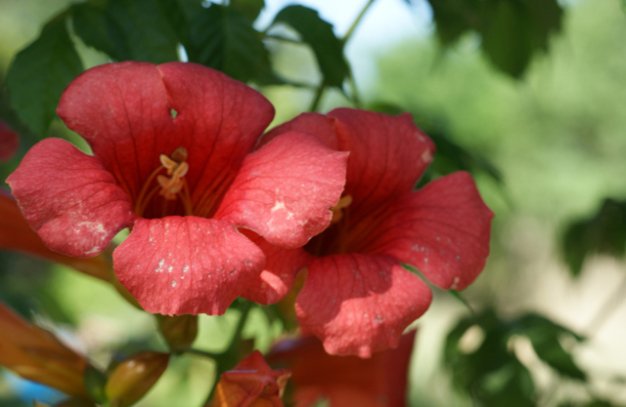
Campsis radicans (Bignonia radicans)
Full sun to light shade; medium to moderately dry moisture level; tolerant of a wide range of soils including coarse sands and gravels, sandy loams to fine silt loams, heavy silts, silty clay loams and stiff clays; slightly acid to neutral pH.
6-40 feet height depending on support (30-40 feet common) by 4-10 feet width; large, reddish orange, fluorescent, trumpet-shaped flowers 2-3 inches long; blooms June through September; 3-5 inch brown seed pods, each containing numerous seeds and each seed having two transparent wings.
Growth Rate: Very fast, growing 10 or more feet in a season
Maintenance: Low maintenance, long-lived vine. Infrequent disease or insect problems. Flowers come from the tips of new growth so blooming is not affected by pruning in early spring. Suckers profusely from underground roots and freely self-seeds which can make it weedy; will form impenetrable colonies. Pruning is an important means of controlling this vine in smaller gardens. Best to train 1-2 main stems up a sturdy support and then every winter cut all the long shoots back to within 6 inches of these main stems. Occasional stem die-back to the ground can occur in severe winters.
Propagation: Seed germination code C(60) at 41 degrees F. or fall sown. Easy from seed. Moderately easy from stem or root cuttings.
Native Region: Statewide
Vine climbs by aerial rootlets and requires sturdy support due to its considerable weight. Foliage grows well in shade but plants need good sun for best flowering. Up to 24 cultivars available including pure red and pure yellow flowers. Has long, deep underground runners so it is difficult to transplant. Attracts hummingbirds, butterflies and bees.
https://tynnativeplants.wordpress.com/vines/scientific-name/trumpet-creeper-trumpet-vine/
This is not the same plant as Pyrostegia. Be careful with common names, always search the Botanical name i provide, then you get the right plant . Thanks for the nice pics though !
Hello my best friend @ctrl-alt-nwo how are you. thank you so much my dear friend.very wonderful flower garden photography. I like it your great full post. thanks for sharing your beautiful life my best friend.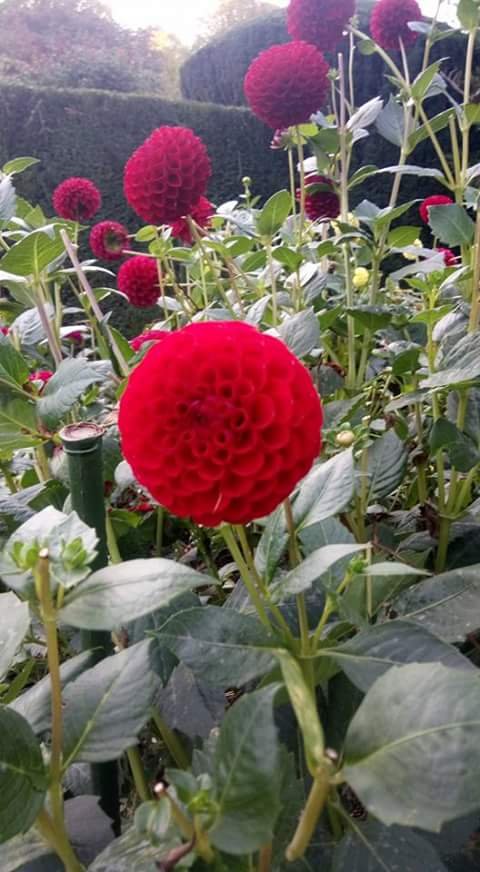
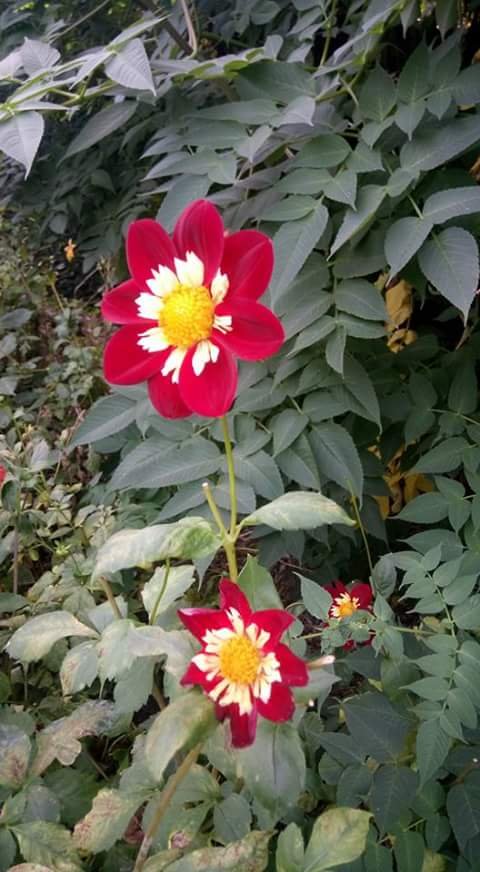
Thank you, my dear friend, sharing this beautiful post to share your beautiful post. I'm so happy to see this new post. You can post many beautiful pictures. Thank you very much. You do not have any comparison. I learn something new from you and try to find friends.
Seeing your beautiful beautiful post, I feel like you have been planting a flower garden for you. Very beautiful flowers, you post. Thank you very much for giving you such beautiful flowers, but I've never seen such beautiful flowers, I have never seen it. First look at first.

Campsis radicans Or Trumpet vine, is a species of flowering plant of the family Bignoniaceae, native to the eastern United States and naturalized in parts of the western United States as well as in Ontario, parts of Europe, and scattered locations in Latin America.Growing to 10 m (33 ft), it is a vigorous, deciduous woody vine, notable for its showy trumpet-shaped flowers. It inhabits woodlands and riverbanks, and is also a popular garden subject.
The flowers are very attractive to hummingbirds, and many types of birds like to nest in the dense foliage. The flowers are followed by large seed pods. As these mature, they dry and split. Hundreds of thin, brown, paper-like seeds are released. These are easily grown when stratified.
Source
The first two pics are not the same plant as Pyrostegia. Be careful with common names, always search the Botanical name i provide, then you get the right plant . Thanks for the nice pics though !
Trumpet vine (Campsis radicans), also known as trumpet creeper, is a fast-growing perennial vine. Growing trumpet vine creepers is really easy and although some gardeners consider the plant invasive, with adequate care and pruning, trumpet vines can be kept under control. Keep reading to learn more about how to grow trumpet vine.
The trumpet vine flower is great for attracting hummingbirds to the landscape. The beautiful tubular flowers range in color from yellow to orange or red. Blooming on the trumpet vine plant takes place throughout summer and into fall, though blooming may be limited for those planted in shady locations.
Source
This is not the same plant as Pyrostegia. Be careful with common names, always search the Botanical name i provide, then you get the right plant . Thanks for the nice pics though !
Campsis Radicans
Bignonia Capriolata
You're growing a fast growing, flowering vine with a trumpet shape that's attracting hummingbirds in big numbers. Everyone who see it in your yard, calls it by a different name. Most commonly the word "trumpet" is in the name. It's understandable if you are a little confused about exactly what to call it. We will help to take a little of the confusion out....just a little.
Trumpet flowers are also sometimes called "Cow Itch". As member of the nightshade family, the leaves have a toxic substance that can cause itching and a rash.
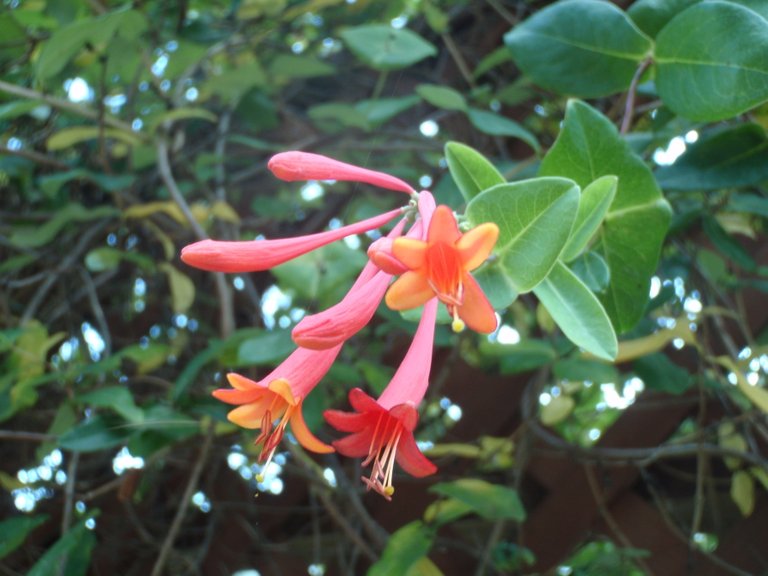
There are two types of Trumpet Flower or Trumpet Flower Vines:
The first is Trumpet Creeper (Campsis Radicans). It can grow 30-40 feet in a season, with a trunk several inches across. It's three inch blooms appear in the summer, earlier in the south. Colors range from yellow and yellow orange to red. This plant is native to the U.S. Gulf Coast and southeastern U.S.
A close relative is the Cross Vine (Bignonia Capriolata). Cross Vine is also commonly called Trumpet Flower, or Trumpet Vine. Cross vines grow shorter vines. The flowers are smaller, growing two to three inches. It blooms early in the spring, and helps to attract returning hummingbirds to your yard for the season. Cross Vines are native to a large area of the U.S. from the mid atlantic states and south to Florida, and west to mid-western states.
At this point, some of you may be thinking "My Trumpet Flower is a bush or a tree." In that case, you are growing Angel Trumpet Flowers, also called Brugmansia.
Hummingbirds are attracted to the bright blooms.


http://www.gardenersnet.com/flower/trumpetflowervine.htm
This is not the same plant as Pyrostegia. Be careful with common names, always search the Botanical name i provide, then you get the right plant . Thanks for the nice pics though !
Trumpet vine is really a beautiful flowers. First time I know about this beautiful flowers. It's beautiful Orange colour impressed me.
source
source
The garden of Trumpet vine looks amazing. Really Australia is the heaven of the world and full of various beautiful flowers.
source
I also appreciate your wonderful photography that you have captured from North Sydney. Always like your flowers article. Eagerly waiting for the next article.
This is not the same plant as Pyrostegia. Be careful with common names, always search the Botanical name i provide, then you get the right plant . Thanks for the nice pics though !
After a long time again i am back @abdt
TRUMPET VINE IN YELLOW
This vigorous climbing, heat-loving, woody vine clings to any surface! Bright yellow trumpet-shaped flowers provide quite a show. Often referred to as Cat Claw because of its ability to climb with claw-like, forked tendrils. This stunner is ideal for covering any sunny wall or fence - even trees! Bloom abundance increases with age. Semi-evergreen. Those words are often used to describe trumpet vine. But you’ll also hear gorgeous, showstopper, breathtaking and indispensable. And therein lies the problem with a beautiful plant that demands a close watch. There are lots of them.

Harvesting Seeds of Trumpet vine
Trumpet vine forms seed pods after blooming, which resemble chubby little bean pods.

What to do with these trumpet vine pods? You can try growing vines from seeds inside.Those interesting looking pods on your Campsis vine have ornamental appeal and are full of seed to save and plant if you choose. Deciding what to do with trumpet vine pods depends upon your patience and adventurous levels. Leaving them on the plant for a fun visual effect is one option, but so is harvesting the seed and propagating more of the rampant vine.
The first two Pics are not the same plant as Pyrostegia venusta. Be careful with common names, always search the Botanical name i provide, then you get the right plant . Thanks for the nice pics though !
yes sir
https://tynnativeplants.wordpress.com/vines/scientific-name/trumpet-creeper-trumpet-vine/
Light: Prefers full sun to light shade. Tolerates partial shade but grows and blooms best with good sunlight.
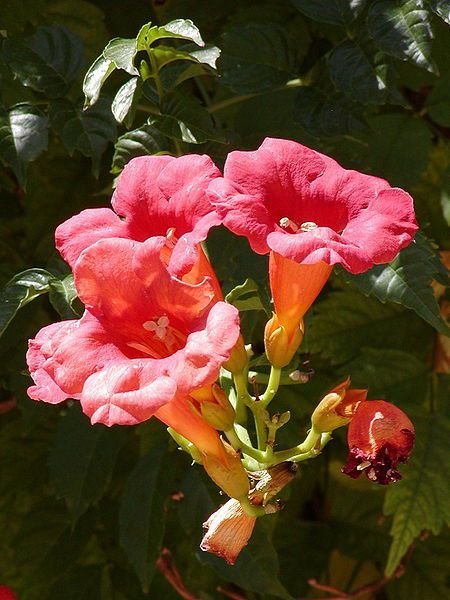.jpg)
Moisture: Medium water needs. Though highly drought tolerant when established, good to water regularly especially during hot and dry seasons.
Soil: Moderately fertile, light and moist, but well-drained soil. It tolerates many kind of soils: acidic, alkaline, clayey, sandy or loamy.
Others: Hard prune after flowering to encourage branching and promote more flowers, as well as to restrain huge and unruly size. It’s hardy and can tolerate severe prune if needed. Benefits from fortnightly or monthly feed with a flowering fertilizer though it require minimal feeding. Generally, pest and disease free but do watch out occasionally for scales, caterpillars and mites.
For subtropical regions: Hardiness: USDA Zone 9-11. Blooms sporadically all year long but perform best from late fall through winter but not in freezing regions. Shelter from cold winds and frost that may ruin young flowers and plant.
https://tynnativeplants.wordpress.com/vines/scientific-name/trumpet-creeper-trumpet-vine/
https://tynnativeplants.wordpress.com/vines/scientific-name/trumpet-creeper-trumpet-vine/
Scientific Classification:
Name: Flame Vine
Scientific Name: Pyrostegia venusta
Suitable terrain: high low
Origin of seeds: cuttings
Seed height: 25-40 cm
https://tynnativeplants.wordpress.com/vines/scientific-name/trumpet-creeper-trumpet-vine/
The first and last Pics are not the same plant as Pyrostegia venusta. Be careful with common names, always search the Botanical name i provide, then you get the right plant . Thanks for the nice pics though !
@ctrl-alt-nw
Oh!That is a Wonderful Garden & really looks for Kangaroo Paws flowers. so great information.
100% like and resteem
It's not Kangaroo Paws, that was one of the previous posts.
Thanks for the information of flowers garden. its very useful.
You are a with a lot of knowledge about the garden. the great work and experience
thanks for sharing.
@ctrl-alt-nwo
Have a nice day.
This is not the same plant as Pyrostegia. Be careful with common names, always search the Botanical name i provide, then you get the right plant . Thanks for the nice pics though !
A vigorous climber grown for its spectacular orange red trumpet shaped flowers borne in late summer to autumn. This plant can grow up to 10m with the aid of support. This plant can be trained into a neat garden shrub but if left unchecked can cling to adjacent trees by way of small aerial rootlets; becoming a rampant pest.
The plant has small aerial roots and clings to almost anything. Small pieces of the plant will easily root in the warmer months so appropriate disposal of garden waste is important.
The plant must not be planted near environmentally sensitive areas as it will escape and invade adjacent natural systems.
Source
The first Pic is not the same plant as Pyrostegia venusta. Be careful with common names, always search the Botanical name i provide, then you get the right plant . Thanks for the nice pics though !
https://tynnativeplants.wordpress.com/vines/scientific-name/trumpet-creeper-trumpet-vine/
Light: Prefers full sun to light shade. Tolerates partial shade but grows and blooms best with good sunlight.
.jpg)
Moisture: Medium water needs. Though highly drought tolerant when established, good to water regularly especially during hot and dry seasons.
Soil: Moderately fertile, light and moist, but well-drained soil. It tolerates many kind of soils: acidic, alkaline, clayey, sandy or loamy.
Others: Hard prune after flowering to encourage branching and promote more flowers, as well as to restrain huge and unruly size. It’s hardy and can tolerate severe prune if needed. Benefits from fortnightly or monthly feed with a flowering fertilizer though it require minimal feeding. Generally, pest and disease free but do watch out occasionally for scales, caterpillars and mites.
For subtropical regions: Hardiness: USDA Zone 9-11. Blooms sporadically all year long but perform best from late fall through winter but not in freezing regions. Shelter from cold winds and frost that may ruin young flowers and plant.
https://tynnativeplants.wordpress.com/vines/scientific-name/trumpet-creeper-trumpet-vine/
https://tynnativeplants.wordpress.com/vines/scientific-name/trumpet-creeper-trumpet-vine/
Scientific Classification:
Name: Flame Vine
Scientific Name: Pyrostegia venusta
Suitable terrain: high low
Origin of seeds: cuttings
Seed height: 25-40 cm
https://tynnativeplants.wordpress.com/vines/scientific-name/trumpet-creeper-trumpet-vine/
Some of these are not the same plant as Pyrostegia. Be careful with common names, always search the Botanical name i provide, then you get the right plant . Thanks for the nice pics though !